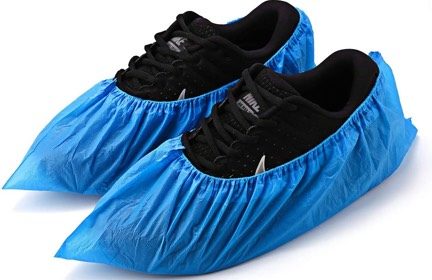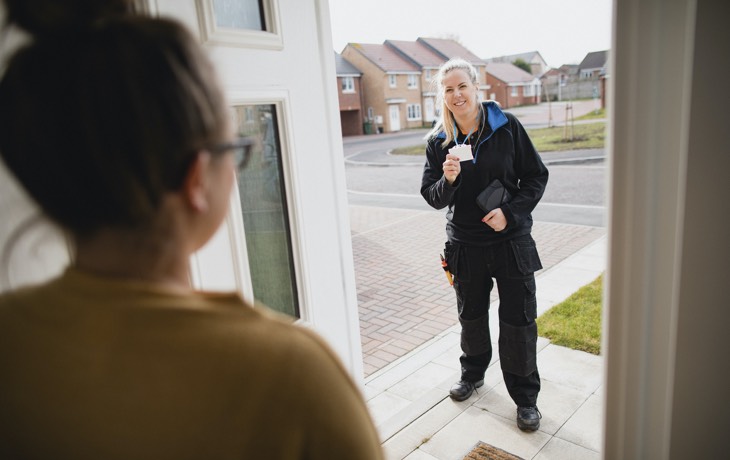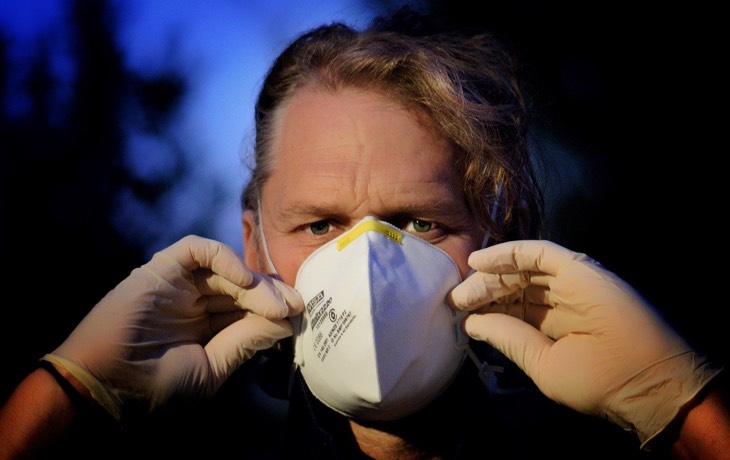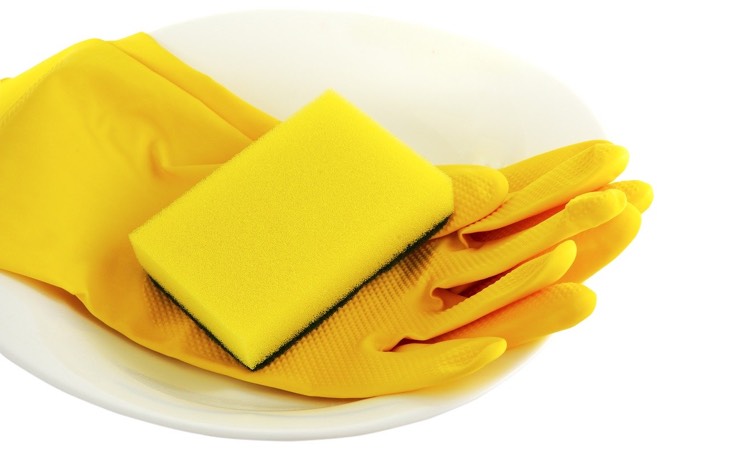You’ve been locked down for weeks. No trips out, no visitors. And then…the toilet breaks. The dishwasher makes a grinding sound. The sink starts leaking. Or in our case, we woke up to no Internet. You need to bring in outside help.
As much as we try to avoid it, there might come a point where you have to invite someone in your house. Of course, now is a good time to get handy — you can do amazing things with a few simple tools and YouTube — but if DIY isn’t an option then you’ll need to prepare to receive a visitor or two.
Here’s what you need to know:
- You have to assume everyone is infected, even if they don’t look at all sick. Some COVID-19 cases are asymptomatic, and some infected people are contagious before showing symptoms.
- Social distancing is the best way to prevent transmission, so get everyone out of the house.
- Have a plan to mitigate potential viral particles in the air, since airborne transmission is a major vector of SARS-CoV-2, and the virus can live in the air for up to three hours.
- Surface contamination is also a concern, so have a plan to disinfect surfaces.
- There may be some risk from feces and shoes, so have a plan for dealing with these possible disease vectors if want to go the extra mile.
- You should try to negotiate safety protocols with the person before they come over. Remind them that it’s just as much for their safety as yours.
This advice comes with a few caveats. First, rational or not, many people take offense to being treated like lepers. So try to handle things as delicately as you can, but be firm. Remember that these strategies aren’t just to protect yourself and your family, but whoever you invite in your home.
Second and most important, the tips in this article are merely mitigation strategies, not surefire methods of preventing SARS-CoV-2 infection. The best thing is to not let strangers in your house.
Breath: yours and theirs
The main vector for SARS-CoV-2 is airborne transmission, so that means watching your breath and theirs. A study in The New England Journal of Medicine found that SARS-CoV-2 can live in the air for up to three hours.
Here are steps you can take to limit potential viral particles in the air:
Distance
Your best bet is distance. The further away you can stay from the person, the better. Ideally, you and your family could leave the house for a while (for either a nice walk outside or a drive) while the outsider works. Of course, that introduces other problems, like theft. You have to weigh the risks.
If leaving the house unoccupied isn’t an option, you should send out whoever you can to limit exposure. If that isn’t practical, isolate them in another part of the house, doors closed.
You should at the very least strive to remain at least six feet away from the outsider at all times, which is the standard advice, though some authorities are skeptical that six feet is enough distance to avoid SARS-CoV-2 spread.
However, even if you are out of the house while the outside works, don’t assume that it’s safe when you reenter. Nature ponders whether virus particles can build up in enclosed spaces over time, and again, SARS-CoV-2 is thought to live in the air for up to three hours.
Face coverings
Besides keeping your distance from the visitor, you also need to consider the total amount of potentially infected droplets expelled into the air. That’s why you must insist that your visitors wear a mask while in your home, and why everyone in your house should also be masked during the visit.
Ideally, these face coverings should be N95 respirators, but that’s probably not realistic now, as they’re nigh-impossible to get.
If you follow one of the mask construction instructions we provided, you might consider making extra to distribute to guests. But understand that the masks themselves should be considered contaminated after use, and should be directly deposited into the washing machine or otherwise disinfected.
As I mentioned in my guide to DIY mask resources, there’s a lot of debate over just how effective facial coverings are at reducing the spread of SARS-CoV-2. This isn’t the place for that debate, but the key takeaway is this: masks help, but they’re not a panacea.
Ventilation
You also want to consider ventilating your space to reduce the amount of airborne virus that accumulates. If you can, open up the windows. Turn on fans to get air circulating. You ideally want to pull old air out and bring fresh air in.
Likewise, if you can, you want to close off as many living areas as you can so stranger spittle doesn’t float into those rooms.
Consider running an air purifier if you have one with a HEPA filter. Wirecutter looked at the available evidence and concluded that it could be helpful, but shouldn’t be relied on as a front-line defense. Set it up in the space the outsiders will most likely be for the majority of their visit.
Time
As I mentioned above, the New England Journal of Medicine reports that the SARS-CoV-2 virus lasts in the air for up to three hours, so if you can keep the house vacated for three hours after the guests leave, that would be ideal. Failing that, try to keep everyone out of the room(s) the stranger was in for at least three hours.
Surfaces
Following air contamination, you need to worry about surface contamination. Coronavirus on hands can be spread to surfaces, and virus particles expelled by talking and coughing can land on surfaces and live for hours or even days.
So after your guests leave, you’ll want to decontaminate as many surfaces as possible in the areas they were in. Start with surfaces they may have touched, but you’ll also want to make sure to disinfect large surfaces like tables, countertops, and the floor.
The EPA offers a list of disinfectants effective against SARS-CoV-2, as does Wirecutter, but here’s a more digestible list of common ones:
- 70% or higher rubbing alcohol
- Clorox disinfectant wipes
- Lysol spray
- Bleach. You need only as much as 4 teaspoons per quart of water.
The CDC offers a guide to cleaning and disinfecting your house.
Feces
One little-discussed potential vector of transmission is poop. According to the CDC, fecal transmission is possible but unlikely.
If your guests have to use your facilities, treat it like any other room: ventilate and sanitize the bathroom as best as you can.
Shoes
Ideally, all guests would take off their shoes before entering your home, to avoid the spread of bacteria and viral particles inside your house. This is especially important now that there’s some scientific support for the idea that the soles of shoes can spread coronavirus.
But with workers, especially those who may be going in and out, having them go shoeless in the house is probably not realistic.
An alternative to doffing shoes is to have guests cover their shoes with disposable shoe covers. Some of our staff keep a box of these by the door for this reason.

Disposable Shoe Covers
You could also have guests disinfect their shoes with a spray cleaner, especially the soles. Spraying a disinfectant blend on the soles of guests’ shoes before they enter your home for the first time will ensure that they’re tracking in anything they picked up at their own home or at a previous location.
Putting it all together: an ideal routine
Here’s an example of how to put this advice into action:
- When you call whoever you need to come over, discuss mitigation measures, such as social distancing, use of masks, etc. to make sure they’re amenable.
- Figure out where they need to go and, if possible, close off and lock all doors where they don’t belong. Open windows and turn on fans in the areas where the visitor will be.
- When the appointed time comes, leave with your family and either leave a door unlocked for them or leave a key in a place they’ve been told to look. Bonus points for disinfecting the key before and after!
- Place a bottle of disinfectant by the door and ask that they disinfect their shoes, especially the soles, before entering your home.
- Place a mask by the door, if you can spare one, and ask them to wear it when in your home.
- Have them call you to let you know they’re done. Pay either electronically, by mail, or leave a check where they can pick it up.
- Stay out of the house for at least three hours after your guest has gone.
- Return, and ideally, enter the house alone and wearing a mask to minimize exposure.
- Mop the floor with a diluted bleach solution, and disinfect all large surfaces and anything the guest presumably touched.
- Wash your hands thoroughly when you’re done
This is, of course, an ideal, and may not be entirely practical. But in any case, the fundamentals are the same: keep a distance, wear protective gear where available, and disinfect surfaces.
Keep in mind that these are mitigation strategies. None of them is a silver bullet, but put together they could lower your chance of infection.


